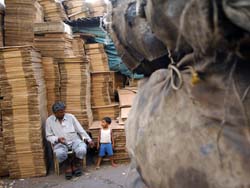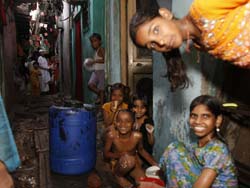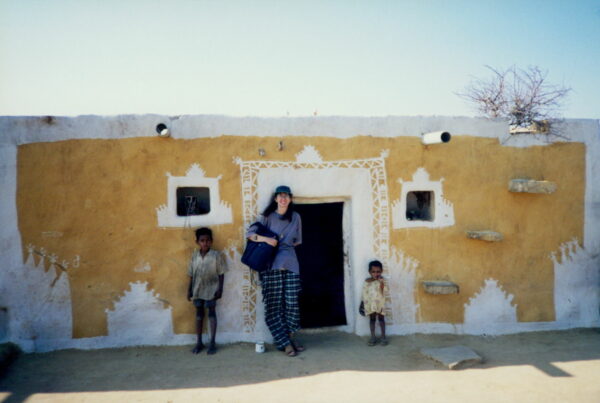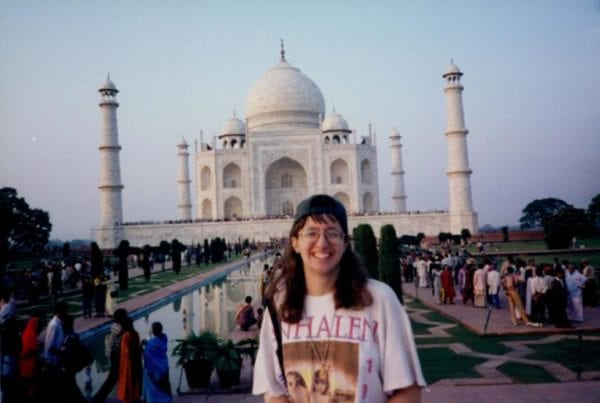 Well, folks, I am back in India and having a whirlwind adventure already! In fact, it’s been hard to keep up with writing down everything I see and feel. Today, I returned to Calcutta, now Kolkata – a city I haven’t seen in thirteen years, and a city in which I started a riot. But more on that later.
Well, folks, I am back in India and having a whirlwind adventure already! In fact, it’s been hard to keep up with writing down everything I see and feel. Today, I returned to Calcutta, now Kolkata – a city I haven’t seen in thirteen years, and a city in which I started a riot. But more on that later.
After landing in Mumbai and trying to shake off jet lag, my hotel manager suggested I take a Reality Tour where you spend an afternoon walking around the Dharavi slum, a community that generates revenue through a variety of industries, and the area where some of the movie Slumdog Millionaire was filmed.
That movie always created a sore spot within me. While it was a great Hollywood story and may have some grains of truth, in my opinion the film just solidified stereotypes of India that do not represent large swaths of the culture. Think dusty, hot, poverty-stricken, and snake charmers. On my 2006 trip to Mumbai I wandered around for hours in the Andheri “slum” and found a very functional village-like atmosphere, with people who spoke several languages, including English, fluently and maintained small businesses.
So to educate myself further I heartily agreed to take the Reality Tour and headed down to Mahim West train station to meet my guide. The company takes a maximum of six people per group to keep things less intrusive, and I will quote their website (http://realitytoursandtravel.com/slum-tour.php) for accuracy:
“On our tours, you will see why Dharavi is the heart of small scale industries in Mumbai (annual turnover is approximately US$ 665 million). We show you a wide range of these activities- from recycling, the making of clay pots, embroidery, bakery, soap factory, leather tanning, papad (poppadom) making and many others, most of which take place in very small spaces.”
I was incredibly impressed with the guide and the company, a non-profit that also started a community center in Dharavi.
Words really do not exist for the time in spent in this amazing place. A slum, I found out, is defined as an area where homes are built illegally, although everyone in the slum pays taxes. I learned so much as we wound our way through narrow alleys, dodged chickens, were invited into a family’s kitchen to chat, and petted several goats that wandered through. We climbed ladders onto rooftops to see how materials from the various businesses were stored, and ducked under men carrying five-foot-tall loads on their backs. We did not even have to sign any kind of waiver!
What amazed me the most was the recycling. Nothing in Mumbai goes to waste because of Dharavi. Much of the world’s “garbage” comes to this slum, and everything from cardboard to paint cans to scrap metal and computer parts are repaired, reworked, refurbished and put back into the marketplace. We visited a variety of industries such as fabric dying, pastry baking, hide tanning, pottery making, embroidery, and more.
 We weaved through crushed plastic, cramped quarters, dark and hot working conditions, families laughing and eating, and machines engineered by the Dharavi residents themselves. The efficiency of the systems there rivaled anything I had ever seen before, and I daresay if the West really wants to “go green” we need to study this community!
We weaved through crushed plastic, cramped quarters, dark and hot working conditions, families laughing and eating, and machines engineered by the Dharavi residents themselves. The efficiency of the systems there rivaled anything I had ever seen before, and I daresay if the West really wants to “go green” we need to study this community!
Hindu and Muslim tensions once ran very high in Dharavi, but our guide informed us that the tension has begun to diffuse significantly and he showed us a Hindu temple with a picture of Jesus Christ on the wall.
We saw the good: hospitals, schools, no beggars, intensive recycling , and the ugly: poor sanitation, open sewers, dangerous work environments. But I hope that for those who have the honor of visiting Dharavi, they will look beyond Slumdog Millionaire into a vital part of India from which we can all learn.
Stay tuned for our adventures as we return to Calcutta!
(As photographs are not allowed in Dharavi, these photos are from Reality Tours website.)





I am sure impressed with the people of this village. My hope is that we, here in the US, can incorporate their recyling techniques, so I hope your Blog get lots of readers. So glad you visited there, Vicki. I’m looking forward to reading more India adventures.
I agree! We should study this place and attempt to master the techniques of intensive recycling. Places like India really make you realize how precious the world’s resources are. We have much to learn from here! I have actually had a spike in blog subscriptions lately!
Vicki, I am really happy that you wrote this blog. I think it is time that people should start to throw away the misconceptions often potrayed in even world-class movies. I’m waiting eagerly to read about your Kolkata for obvious reasons.
Thanks Anindita. I’m so glad you enjoyed the blog entry, and I agree that the movies can do unintended damage to a community. This particular movie really bothered me, but now I feel in a better position to give accurate information about Dharavi. I’m working on Kolkata now! I’ll look forward to your comments.